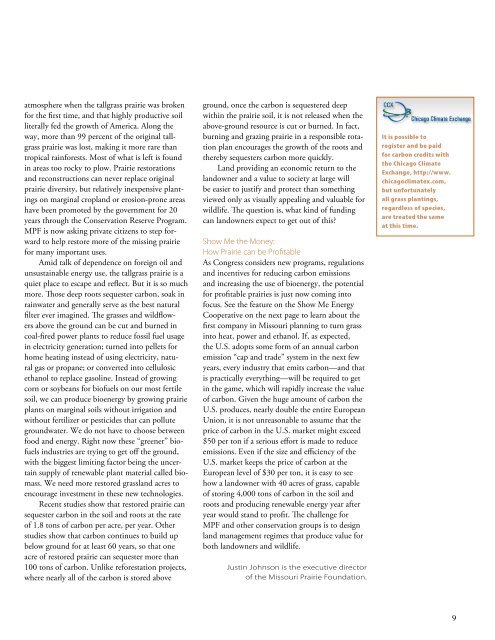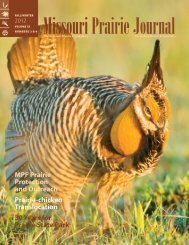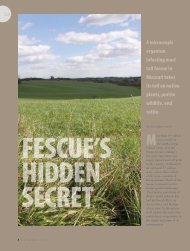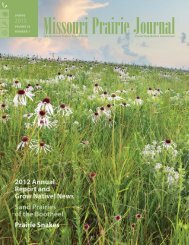Fall 2007: Volume 28, Number 4 - Missouri Prairie Foundation
Fall 2007: Volume 28, Number 4 - Missouri Prairie Foundation
Fall 2007: Volume 28, Number 4 - Missouri Prairie Foundation
You also want an ePaper? Increase the reach of your titles
YUMPU automatically turns print PDFs into web optimized ePapers that Google loves.
atmosphere when the tallgrass prairie was brokenfor the first time, and that highly productive soilliterally fed the growth of America. Along theway, more than 99 percent of the original tallgrassprairie was lost, making it more rare thantropical rainforests. Most of what is left is foundin areas too rocky to plow. <strong>Prairie</strong> restorationsand reconstructions can never replace originalprairie diversity, but relatively inexpensive plantingson marginal cropland or erosion-prone areashave been promoted by the government for 20years through the Conservation Reserve Program.MPF is now asking private citizens to step forwardto help restore more of the missing prairiefor many important uses.Amid talk of dependence on foreign oil andunsustainable energy use, the tallgrass prairie is aquiet place to escape and reflect. But it is so muchmore. Those deep roots sequester carbon, soak inrainwater and generally serve as the best naturalfilter ever imagined. The grasses and wildflowersabove the ground can be cut and burned incoal-fired power plants to reduce fossil fuel usagein electricity generation; turned into pellets forhome heating instead of using electricity, naturalgas or propane; or converted into cellulosicethanol to replace gasoline. Instead of growingcorn or soybeans for biofuels on our most fertilesoil, we can produce bioenergy by growing prairieplants on marginal soils without irrigation andwithout fertilizer or pesticides that can pollutegroundwater. We do not have to choose betweenfood and energy. Right now these “greener” biofuelsindustries are trying to get off the ground,with the biggest limiting factor being the uncertainsupply of renewable plant material called biomass.We need more restored grassland acres toencourage investment in these new technologies.Recent studies show that restored prairie cansequester carbon in the soil and roots at the rateof 1.8 tons of carbon per acre, per year. Otherstudies show that carbon continues to build upbelow ground for at least 60 years, so that oneacre of restored prairie can sequester more than100 tons of carbon. Unlike reforestation projects,where nearly all of the carbon is stored aboveground, once the carbon is sequestered deepwithin the prairie soil, it is not released when theabove-ground resource is cut or burned. In fact,burning and grazing prairie in a responsible rotationplan encourages the growth of the roots andthereby sequesters carbon more quickly.Land providing an economic return to thelandowner and a value to society at large willbe easier to justify and protect than somethingviewed only as visually appealing and valuable forwildlife. The question is, what kind of fundingcan landowners expect to get out of this?Show Me the Money:How <strong>Prairie</strong> can be ProfitableAs Congress considers new programs, regulationsand incentives for reducing carbon emissionsand increasing the use of bioenergy, the potentialfor profitable prairies is just now coming intofocus. See the feature on the Show Me EnergyCooperative on the next page to learn about thefirst company in <strong>Missouri</strong> planning to turn grassinto heat, power and ethanol. If, as expected,the U.S. adopts some form of an annual carbonemission “cap and trade” system in the next fewyears, every industry that emits carbon—and thatis practically everything—will be required to getin the game, which will rapidly increase the valueof carbon. Given the huge amount of carbon theU.S. produces, nearly double the entire EuropeanUnion, it is not unreasonable to assume that theprice of carbon in the U.S. market might exceed$50 per ton if a serious effort is made to reduceemissions. Even if the size and efficiency of theU.S. market keeps the price of carbon at theEuropean level of $30 per ton, it is easy to seehow a landowner with 40 acres of grass, capableof storing 4,000 tons of carbon in the soil androots and producing renewable energy year afteryear would stand to profit. The challenge forMPF and other conservation groups is to designland management regimes that produce value forboth landowners and wildlife.Justin Johnson is the executive directorof the <strong>Missouri</strong> <strong>Prairie</strong> <strong>Foundation</strong>.It is possible toregister and be paidfor carbon credits withthe Chicago ClimateExchange, http://www.chicagoclimatex.com,but unfortunatelyall grass plantings,regardless of species,are treated the sameat this time.
















